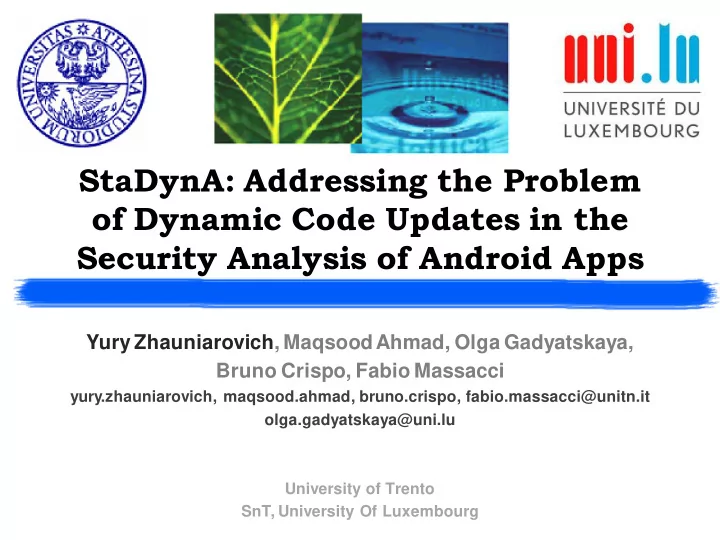

StaDynA: Addressing the Problem of Dynamic Code Updates in the Security Analysis of Android Apps Yury Zhauniarovich, MaqsoodAhmad, Olga Gadyatskaya, Bruno Crispo, Fabio Massacci yury.zhauniarovich, maqsood.ahmad, bruno.crispo, fabio.massacci@unitn.it olga.gadyatskaya@uni.lu University of Trento SnT, University Of Luxembourg
Analysis Types Static analysis – is the analysis of applications which is performed without the actual execution of an application Dynamic analysis – is the analysis which is performed by executing an application in real or emulated environments 2
Dynamic Code Updates* Android Package (.apk) Dalvik VM .dex resources. files arsc uncompiled resources assets AndroidManifest.xml code files Method.invoke (jar, dex ,…) 1. Dynamic Class Loading (DCL) 2. Reflection DexFile.loadDex * S. Poeplau et al. “Execute This! Analyzing Unsafe and Malicious Dynamic Code Loading in Android Applications”. In Proc. Of NDSS’14 3
Motivation In Android, code loaded dynamically has the same privileges as original Static analyzers cannot fully inspect an app in the presence of dynamic code update features (AndroGuard, FlowDroid, etc.) Heavily used by malware to conceal malicious behavior Used in real applications to bypass Android limitations 4
Reflection and DCL Usage Google Play: – analyzed 13863 apps – 19% contain DCL calls – 88% use reflection Third-party markets: – analyzed 14283 apps from 6 markets – 6% contain DCL calls (F-Droid: 1%) – 74% use reflection (F-Droid: 57%) Malware dataset: – 1260 samples analyzed – 20% contain DCL calls – 81% use reflection 5
Representative Example 6
Problem: Dynamic Code Updates Issue: How to analyze Android apps in the presence of reflection calls, – detect the name of the called function/class dynamic class loading? – download and analyze the loaded code Method Call Graph (MCG) is a directed graph showing the calling relationships between methods in a computer program 7
StaDynA: Idea Apps with Dynamic Code Update features expose their dynamic behavior at runtime IDEA: combine static and dynamic analysis techniques to detect and explore Dynamic Code Update features 8
StaDynA: Overview 9
StaDynA: Approach Find API calls responsible for reflection and DCL at static time (we name the methods calling these API functions as Methods of Interest (MOI) ) Analyze their behavior at runtime 10
StaDynA: Workflow 11
StaDynA: Features Stores and analyzes the code loaded dynamically Builds MCG of the app including the information obtained at runtime Tmp testMeth ()V Method.invoke Discovers at runtime the qualifiers of the methods/constructors DexFile.loadDex called through reflection SmsManager sendDataMessage Discovers suspicious behavior patterns SMS_SEND 12
StaDynA: Evaluation Dataset: – 5 benign (FlappyBird, Norton AV, Avast AV, Viber, Floating Image) – 5 malicious (FakeNotify.B, AnserverBot, BaseBridge, DroidKungFu4, SMSSend) The dataset is small: – StaDynA requires manual triggering Evaluation parameters: – the increase of the MCG – coverage of the MOI detected in the application – discovered suspicious patterns 13
Evaluation: MCG Increase 14
Evaluation: Coverage 15
Evaluation: Suspicious Patterns Access to the functionality protected with dangerous permissions from the loaded code Ticks show that the usage of the corresponding permission has not been found in the initial app file (over-privileged apps) 16
FakeNotify.B before StaDynA 17
FakeNotify.B after StaDynA 18
StaDynA: Issues Manual triggering Resolution of all reflection targets is done at runtime The information obtained during different runs is not merged No separation according to the name of the package (UID is used instead) Not all types of dynamic code updates have been covered 19
StaDynA: Summary Dynamic code updates is a serious problem for Android – the code loaded dynamically has the same privileges as the original application We proposed an approach that facilitates the analysis of apps in the presence of reflection and DCL – discovers at runtime the qualifiers of the methods/constructors called through reflection – stores and analyzes code loaded dynamically – builds MCG of the app including the information obtained at runtime – discovers suspicious behavior patterns Open-source: https://github.com/zyrikby/StaDynA 20
BACKGROUND SLIDES 21
StaDynA: Main Function 22
Analysis of Invoke Event 23
Analysis of DCL Event 24
Recommend
More recommend